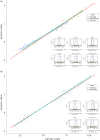Testing hypotheses of marsupial brain size variation using phylogenetic multiple imputations and a Bayesian comparative framework
- PMID: 33784860
- PMCID: PMC8059968
- DOI: 10.1098/rspb.2021.0394
Testing hypotheses of marsupial brain size variation using phylogenetic multiple imputations and a Bayesian comparative framework
Abstract
Considerable controversy exists about which hypotheses and variables best explain mammalian brain size variation. We use a new, high-coverage dataset of marsupial brain and body sizes, and the first phylogenetically imputed full datasets of 16 predictor variables, to model the prevalent hypotheses explaining brain size evolution using phylogenetically corrected Bayesian generalized linear mixed-effects modelling. Despite this comprehensive analysis, litter size emerges as the only significant predictor. Marsupials differ from the more frequently studied placentals in displaying a much lower diversity of reproductive traits, which are known to interact extensively with many behavioural and ecological predictors of brain size. Our results therefore suggest that studies of relative brain size evolution in placental mammals may require targeted co-analysis or adjustment of reproductive parameters like litter size, weaning age or gestation length. This supports suggestions that significant associations between behavioural or ecological variables with relative brain size may be due to a confounding influence of the extensive reproductive diversity of placental mammals.
Keywords: Bayesian; brain; comparative; imputations; marsupials; phylogenetic.
Figures



References
-
- Jerison HJ. 1973. Evolution of the brain and intelligence. New York, NY: Academic Press.
Publication types
MeSH terms
Associated data
LinkOut - more resources
Full Text Sources
Other Literature Sources
